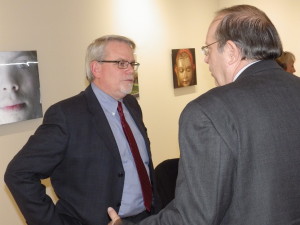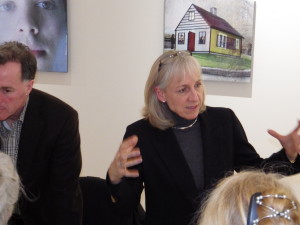Kenneth Lisk, president of Lacey Precision Engineered Products in Bridgeport turned the tables on a reporter waiting to ask him a question recently. Lisk had just finished a hundred-person, packed-house manufacturing roundtable at the University of Bridgeport.
“What did you just get out of it?” he asked.
The response: “Cause for optimism in manufacturing.”
And with the passion he obviously possesses for making things, Lisk, an engineer who takes notes on graph paper, offered a “Eureka!” response: “You got it!”

Regionally, as three manufacturers attested in a University of Bridgeport forum co-sponsored by the Fairfield County Business Journal and WSHU Public Radio, you can make it here, but you have to be on your toes. For reasons from real estate to transportation and beyond, the crowd heard firsthand that it is expensive to do business locally.
Across a two-hour program, a consistent theme was of a fresh breeze on the factory floor. As was repeated several times: Gone is the dim lighting; gone are the medieval whips.
Manufacturing is now lean, clean and technically driven. It is also savvy, as evidenced by Stratford-based, 200-employee, 2,000-product-line Bridgeport Fittings Inc., whose Executive Vice President Thomas S. Auray said, “We spend a lot of time and money defending company patents.” The company is family owned and once topped out at 340 employees. A recent modernization upped productivity and reduced scrap, yet still, “We”™re not the cheapest guy in town,” he said. “But the other guys don”™t make what they sell. We make 70 percent of what we sell in Stratford in-house.”
Auray credited an in-house survey of a decade ago as an attention-getter and, perhaps, object lesson in modern manufacturing. “The survey said we were going from a great company to a good company,” he said. “Good just isn”™t going to cut it in a place like Connecticut where it”™s expensive to do business.”
Hiring a nimble workforce is key, but today”™s manufacturing worker, too, must mimic the industry. Workers must be adaptable and, unlike the drone workers embodied in Fritz Lang”™s “Metropolis,” entrepreneurial.
The demand is real for such talent, as Kathy Saint, owner and president of Schwerdtle Stamp, a 135-year-old, family-owned business, said. The company makes stamping dies from materials like steel, brass and silicone with the motto: “They make the tools that put your art on your part.”

Saint, who employs 20, said the work is there, but the work force can be wanting. She cited an in-house test that regional high school graduates routinely fail and said, “If you can find a tap-and-die worker without a job right now, then you know that person is not very good at what they do. Because if you are good, you have a job.”
Lisk said, distilling life and history, “If you think about it, there”™s manufacturing and there”™s agriculture. You make something grow out of the ground or you make something by using resources to make it. Everything else is just shuffling money.”
Auray, Saint and Lisk constituted the panel. A measure of enthusiasm for their expertise surfaced at night”™s end when they were swamped by audience members with questions after the official Q-and-A session was called on account of time. Hardly idle chatter, those who came forward included Dean Lloyd Gibson of the UB School of Business. The panelists graciously stayed late.
Event moderation is usually a supportive role, but not so this night. At the podium to the panel”™s left stood Jonathan J. Winkel, a regional business manager in software for Eastman Kodak Co. in Stamford and a member of the Governor”™s Commission on Connecticut”™s Future.
That commission in December will deliver a “comprehensive report” to Gov. Dannel P. Malloy on “challenges faced by Connecticut and Connecticut”™s economy,” Winkel said afterward.
The commission”™s focus includes “existing resources and infrastructure and their ability to secure and enhance Connecticut”™s key sectors,” said Winkel, “including insurance, financial services, life sciences and health care, advanced manufacturing and tourism.
“Those are the drivers that we need to use to move forward.”


















